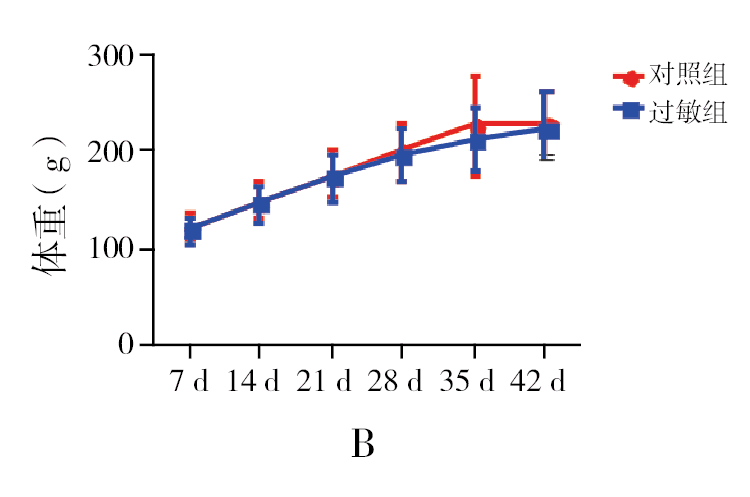 PDF(1435 KB)
PDF(1435 KB)


 PDF(1435 KB)
PDF(1435 KB)
 PDF(1435 KB)
PDF(1435 KB)
经口食物过敏大鼠动物模型的建立
Establishment of a rat model of oral food allergy
目的 采用卵清蛋白 (OVA) 经口灌胃,在无佐剂条件下激发建立挪威棕色 (BN) 大鼠食物过敏模型,并对该模型进行评价。方法 20只3周龄雄性BN大鼠随机分为过敏组和对照组 (n=10)。过敏组每日给予OVA 1mg/只灌胃,连续41d;第42天过敏组给予OVA 100mg/只灌胃激发;对照组给予等量生理盐水灌胃。测量两组大鼠第7、14、21、28、35和42天身长、体重、进食量的差异;ELISA法检测第42天激发后两组大鼠血清OVA-IgE水平和血浆组胺水平,并观察两组大鼠外观和粪便性状的变化;根据血清OVA-IgE含量≥对照组大鼠血清OVA-IgE含量均数+3标准差判定食物过敏模型建模成功。结果 过敏组和对照组大鼠各时间点身长和体重比较差异均无统计学意义 (P > 0.05);第21天时对照组大鼠进食量大于过敏组 (P < 0.05)。第42天激发后,过敏组大鼠血清OVA-IgE和血浆组胺水平明显高于对照组 (P < 0.05),致敏率 (建模成功率) 为90%。两组大鼠粪便性状未观察到有明显差异。结论 采用全程OVA经口灌胃,且不使用佐剂诱导的BN大鼠食物过敏模型建立成功,且成功率较高;OVA所引起的食物过敏短期内有可能会引起进食量的减低,但尚未发现对大鼠的身长和体重增长造成影响。
Objective To establish a food allergy model in Brown Norway (BN) rats by gavage of ovalbumin (OVA) without any adjuvant, and to evaluate this model. Methods A total of 20 male BN rats aged 3 weeks were randomly divided into allergy group and control group (n=10 each). BN rats in the allergy group were given OVA 1 mg per day by gavage, and all the rats were treated for 41 days continuously. On day 42, the rats in the allergy group were given OVA 100 mg by gavage for challenge. The rats in the control group were given normal saline of the same volume by gavage. Differences in body length, body weight, and food intake were compared between the two groups on days 7, 14, 21, 28, 35, and 42. ELISA was used to measure the serum OVA-IgE level and plasma histamine level after challenge on day 42, and the changes in rats' appearance and fecal properties were observed. The model of food allergy was considered successful when the serum OVA-IgE level in the allergy group was no less than the mean serum OVA-IgE level + 3 standard deviation in the control group. Results There were no significant differences in body length, body weight or food intake between the allergy and control groups at all time points (P > 0.05). On day 21, the control group had a significantly higher food intake than the allergy group (P < 0.05). On day 42 after challenge, the allergy group showed significantly higher serum OVA-IgE and plasma histamine levels than the control group (P < 0.05). The sensitization rate (rate of successful modeling) was 90%. The fecal properties showed no significant differences between the two groups. Conclusions OVA by gavage without any adjuvant can successfully establish the model of food allergy in BN rats and has a high success rate. Food allergy induced by OVA may reduce food intake within a short period of time, but no influence on rats' body length or body weight has been observed.

[1] Sicherer SH.Epidemiology of food allergy[J].J Allergy Clin Immunol,2011,127(3):594-602.
[2] Bartnikas LM,Sheehan WJ,Larabee KS,et al.Ovomucoid is not superior to egg white testing in predicting tolerance to baked egg[J].J Allergy Clin Immunol Pract,2013,1(4):354-360.
[3] Turner PJ,Mehr S,Joshi P,et al.Safety of food challenges to extensively heated egg in egg-allergic children:a prospective cohort study[J].Pediatr Allergy Immunol,2013,24(5):450-455.
[4] Tan RA,Corren J.The relationship of rhinitis and asthma,sinusitis,food allergy,and eczema[J].Immunol Allergy Clin North Am,2011,31(3):481-491.
[5] Oyoshi MK,Oettgen HC,Chatila TA,et al.Food allergy:Insights into etiology,prevention,and treatment provided by murine models[J].J Allergy Clin Immunol,2014,133(2):309-317.
[6] Johnston LK,Chien KB,Bryce PJ.The immunology of food allergy[J].J Immunol,2014,192(6):2529-2534.
[7] Knippels LM,Penninks AH,van Meeteren M,et al.Humoral and cellular immune responses in different rat strains on oral exposure to ovalbumin[J].Food Chem Toxicol,1999,37(8):881-888.
[8] Liu ZQ,Zheng PY,Yang PC.Hapten facilitates food allergen-related intestinal hypersensitivity[J].Am J Med Sci,2013,345(5):375-379.
[9] Ahrens B,Quarcoo D,Buhner S,et al.Development of an animal model to evaluate the allergenicity of food allergens[J].Int Arch Allergy Immunol,2014,164(2):89-96.
[10] Claude M,Lupi R,Bouchaud G,et al.The thermal aggregation of ovalbumin as large particles decreases its allergenicity for egg allergic patients and in a murine model[J].Food Chem,2016,203:136-144.
[11] Li XM,Schofield BH,Huang CK,et al.A murine model of IgE-mediated cow's milk hypersensitivity[J].J Allergy Clin Immunol,1999,103(2 Pt 1):206-214.
[12] Akiyama H,Teshima R,Sakushima JI,et al.Examination of oral sensitization with ovalbumin in Brown Norway rats and three strains of mice[J].Immunol Lett,2001,78(1):1-5.
[13] Sun N,Zhou C,Pu Q,et al.Allergic reactions compared between BN and Wistar rats after oral exposure to ovalbumin[J].J Immunotoxicol,2013,10(1):67-74.
[14] Knippels LM,Penninks AH.Assessment of the allergic potential of food protein extracts and proteins on oral application using the brown Norway rat model[J].Environ Health Perspect,2003,111(2):233-238.
[15] Knippels LM,van der Kleij HP,Koppelman SJ,et al.Comparison of antibody responses to hen's egg and cow's milk proteins in orally sensitized rats and food-allergic patients[J].Allergy,2000,55(3):251-258.
[16] Dearman RJ,Kimber I.Animal models of protein allergenicity:potential benefits,pitfalls and challenges[J].Clin Exp Allergy,2009,39(4):458-468.
[17] Pilegaard K,Madsen C.An oral Brown Norway rat model for food allergy:comparison of age,sex,dosing volume,and allergen preparation[J].Toxicology,2004,196(3):247-257.
[18] Isolauri E,Sütas Y,Salo MK,et al.Elimination diet in cow's milk allergy:risk for impaired growth in young children[J].J Pediatr,1998,132(6):1004-1009.
[19] Christie L,Hine RJ,Parker JG,et al.Food allergies in children affect nutrient intake and growth[J].J Am Diet Assoc,2002,102(11):1648-1651.
[20] 刘俊红,吴斌,赖乾坤,等.SD幼鼠食物过敏模型的建立与评价[J].临床儿科杂志,2013,31(10):953-958.
[21] Robbins KA,Wood RA,Keet CA.Milk allergy is associated with decreased growth in US children[J].J Allergy Clin Immunol,2014,134(6):1466-1468.
[22] Birmingham N,Payankaulam S,Thanesvorakul S,et al.An ELISA-based method for measurement of food-specific IgE antibody in mouse serum:an alternative to the passive cutaneous anaphylaxis assay[J].J Immunol Methods,2003,275(1-2):89-98.
国家自然科学基金(81172686;81302446);上海市儿科学重点学科、上海市医学重点学科资助项目(05Ⅲ002)。